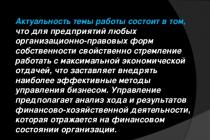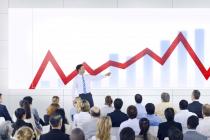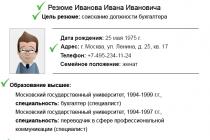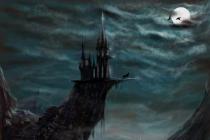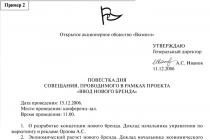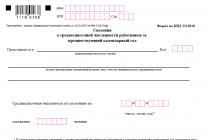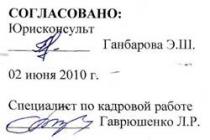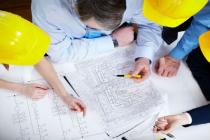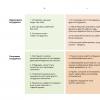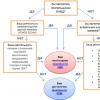General assessment of financial condition.
Liquidity assessment.
Assessment of financial stability.
Cash flows and their impact on
financial stability.
Efficiency assessment
property. Before proceeding with the analysis of financial
state of the enterprise, it is required to accurately determine
the original purpose of the analysis. The level of detail depends on the goal
and depth of research in individual areas of analysis:
Cost structure analysis
Analysis of the structure of the balance sheet and working capital
Liquidity and financial stability analysis
Cash flow analysis
Turnover analysis
Profitability Analysis
Analysis of company performance The following types of analysis are recommended:
Express diagnostics of the enterprise
Assessment of the financial performance of an enterprise
Preparation of justification for investments The analysis makes it possible to evaluate:
Financial position of the company
Property status of the enterprise
Degree of business risk (possibility of repayment
obligations to third parties)
Capital adequacy for current activities and long-term
investment
Need for long-term sources of financing
Capacity to increase capital
Rational use of borrowed funds
Company performance Principles of analysis
Data assessment is impossible without comparing them
Invalid data
inaccurate
results
Don't mix incompatible data
Consider relationships
Draw conclusions. Make decisions Analysis stages
Collection and
Preparation
original
information
Analytical
treatment
Interpretation
results
Financial
reporting
Balance
Analytical Statistical Interview
certificates
information
Form
№
Calculation of necessary
data
Conclusions and
Recommendations
Relationship between indicators
Possible solutions
problems Problems solved
express diagnostics
Diagnostics are carried out to obtain a small
number of key, most informative
indicators that provide accurate and objective
picture of the financial condition of the enterprise
Express diagnostics allows identifying painful
points in the activities of the enterprise and offer
Possible ways out of critical situations Using the proposed methods, the company
may find a solution to some account problems
own funds and resources
In the process of working on the proposed
techniques from managers and specialists
various services performing analytical
functions, thinking is formed that meets
requirements of work in market conditions Analysis of financial indicators
Implementation analysis
- Analysis of the structure of the financial results report
- Cost analysis
Analysis of changes in items and balance sheet structure
- Asset analysis
- Liability analysis
Cash flow analysis Liquidity and financial analysis
-
sustainability
Turnover analysis
Turnover of current assets and liabilities
Duration of the financial cycle
Performance analysis
companies
Asset turnover
Return on sales
Return on assets Analysis of financial statements
results
During the analysis of this document
The shares are calculated according to
Individual elements:
Cost price
Operating profit
Payment of interest and taxes
Net profit
Reinvestment profit
This allows you to assess the degree
influence of individual indicators
to the final value of net and
reinvested profits
100%
90%
80%
70%
60%
50%
40%
30%
20%
10%
0%
I year
II year
III year Aggregated structure
balance
ASSETS
Current assets
Are located
in order
descending
liquidity
LIABILITIES
Current
obligations
Long-term
obligations
Permanent
assets
Own
capital
Are located
in order
distance
repayment
debt
Joint Stock
capital
Own working capital = Current assets – Current liabilities Relationship between the income statement and the balance sheet (in aggregate form)
Balance sheet
Gains and losses report
A
TO
T
AND
IN
Y
Commercial and
administrative expenses
Expenses unrelated to
main activity
Interest for
loans
Tax
And
P
A
WITH
WITH
AND
IN
Y
other expenses
Dividends
Increase
assets
Increase
own
capital Revenues from sales
Gross profit
Operating profit
Profit before interest and taxes
Profit before taxes
Net profit
Reinvested earnings Asset structure analysis
It is necessary to determine the ratio and change of articles:
Current assets
Cash
Accounts receivable
- for goods and services
- on advances issued
- for other debtors
Inventories
- raw materials and supplies
- work in progress
- finished products
Non-current (permanent) assets
- fixed assets
- intangible assets
- other non-current assets
Cash
Accounts receivable
debt
Reserves
Non-negotiable
(permanent)
assets Liability structure analysis
Current
obligations
In the structure of liabilities
calculate:
Short term
obligations
short-term
loans
creditor
debt
Long-term loans
Equity
authorized capital
Extra capital
reinvested profits
Short term
loans
Creditor's
debt
Long-term
loans
Own
facilities Own working capital
The amount of own working capital is
difference between current assets
and current obligations.
Current
assets
Current
obligations
Own
negotiable
facilities Balance assessment
Analysis of changes in structure and changes in articles
balance shows:
what is the value of current and permanent assets, how
their ratio changes, and also due to what they
are funded
which articles are growing at a faster pace, and how
affects the structure – balance
what proportion of assets are inventories
inventories and receivables how large is the share of own funds and in
to what extent does the company depend on debt?
funds
what is the spread of borrowed funds across
urgency
what share of liabilities is debt?
before the budget, banks and labor collective Cash flows
Cash flows are distinguished:
from the main activity (operating): movement
funds in progress
production and sales of main products
from investment activities: income and expenses from
investing funds and
sale of non-current assets
from financial activities: receipt and payment
loans, issue of shares, etc. Cash flow generation scheme
Raw materials
Unfinished
production
Salary,
expenses
Finished products
Accounts receivable
debt
Creditor's
debt
Cash
facilities
operating room
profit
Depreciation "tributaries"
"outflows"
Interest on
loans
Taxes
Payment from profit
Sale
long term
assets
Acquisition
long-term assets
Capital
construction
Sale of shares
Loan repayment
Receipt
loans
Dividends
BASIC
ACTIVITY
INVESTMENT
ACTIVITY
FINANCIAL
ACTIVITY Cash flows
Cash flow analysis allows you to get
answers on questions:
1.What explains the differences between the profit received and
availability of cash
funds?
2. Where did the funds come from and what were they used for?
3. Are the funds received sufficient for maintenance?
current activities?
4. Does the enterprise have enough funds for investment?
activities?
5. Is the company able to pay off its current
debts? Liquidity analysis
Balance sheet liquidity shows to what extent
the company is able to pay
short-term liabilities with current assets.
total liquidity. Two other coefficients
used when deepening is necessary
analysis to reflect the impact of individual items
current assets. Coefficient
general
liquidity
Coefficient
fast
(urgent)
liquidity
Coefficient
absolute
liquidity
Current assets
Current responsibility
Den. Wed Krat. Finnish enclosed Deb. h.
Current responsibility
Den. Wed Krat. Finnish invest
Current responsibility Balance sheet liquidity assessment
companies (example)
OJSC "Oil and Fat Plant "Solntse"
1.1.02
1.1.03
1.1.04
Total coefficient
liquidity
1,37
1.98
1,16
Fast ratio
liquidity
0,88
0,51
0,29
0,01
0,02
0,01
Coefficient
absolute liquidity 1,40
1,20
1,00
0,80
0,60
0,40
0,20
1.1.02
1.1.03
Total liquidity ratio
Quick ratio
Absolute liquidity ratio
1.1.04The dynamics of liquidity indicators indicate
slight decrease in overall liquidity with
a sharp drop in the quick liquidity ratio.
This indicates an increase in low liquidity
elements (stocks) in the structure of current assets. All
this indicates an increase in the riskiness of activities
companies from the point of view of non-repayment of debts and reduction
real level of solvency.
In addition, it is necessary to analyze the degree
accounts receivable and inventory to receive
a more realistic picture. Financial stability assessment
Financial stability reflects the level of risk
activities of the company and dependence on borrowed funds
capital.
You can use the coefficient as a base
financing. Autonomy coefficients and
maneuverability of own funds allow us to give
more detailed assessment of the capital structure.
The following are used as evaluation coefficients:
Coefficientfinancing
Own funds
Borrowed funds
Coefficient
autonomy
Own funds
Total assets
Coefficient
maneuverability
own
funds
Own working capital
Own funds Turnover of current assets and liabilities
Turnover
accounts receivable
debt
Turnover
reserves
Implementation
Cost price
Deb. debt
Reserves
Turnover
creditor
debt
Cost price
Credit. debt Turnaround period
accounts receivable
debt
(Implementation period)
turnover period
reserves
Turnaround period
creditor
debt
360
360
360
Obor. deb. debt
Inventory turnover
Revolving credit debt Financial cycle
Based on current asset turnover indicators
liabilities, the duration of the financial period is calculated
cycle.
It is defined as the sum of the turnover period
accounts receivable and inventories less
period of turnover of accounts payable. Period
turnover
reserves
Turnaround period
accounts receivable
debt
Turnaround period
creditor
debt
Financial
cycle
The higher
duration
financial cycle,
the higher the need
in working capital Period of turnover of current assets and
liabilities (example)
OJSC Oil and Fat Plant "Solntse"
Turnaround period
(days)
Accounts receivable
2002
37,2
85,8
117,9
Inventories
26,4
96,4
270,3
Credit. debt
39,8
64,9
209,3
Manufacturer - commercial
cycle
23,8
117,3
178,9
2003
2004The increase in the duration of the financial cycle in 2004 was caused by
a sharp increase in the inventory turnover period, which does not
could be compensated by a slowdown in the turnover period
accounts payable.
This is due to the stockpiling policy pursued by
management of the enterprise. Turnover periods of current assets and liabilities (days)
0,0
100,0
200,0
300,0
400,0
Inventories
Accounts receivable
debt
Creditor's
debt
2004
2003
2002
Financial cycle
2004
2003
2002
0,0
20,0
40,0
60,0
80,0
100,0
120,0 140,0 160,0 180,0Asset turnover
The asset turnover ratio reflects
how many times during the turnover period, capital
invested in the assets of the enterprise. Growth of this
indicator indicates an increase in their efficiency
use.
Another parameter that evaluates the intensity
asset utilization is an indicator of the period
turnover in days, calculated as a ratio
duration of the selected period to turnover
assets for a given period. Report on
financial
results
R
E
A
L
AND
Z
A
C
AND
I
Balance
(are used
average
values for
period)
A
TO
T
AND
IN
Y
P
A
WITH
WITH
AND
IN
Y Return on sales
Revenues from sales
7 110
Product cost
Operating profit
5 434
1 676
Non-operating income and losses
1 050
Profit from activities
2 726
Interest
0
Profit before tax
Budget payments from profits
other expenses
562
- 398
Net profit
Dividends paid
0
Reinvested earnings
II quarter 2004
2 726
2 562
0
JSC "Electroinstrument"
Operating profit
Revenues from sales Return on sales =
Operating profit
Revenues from sales
Return on sales = 23.6%
Return on sales shows
what percentage of operating profit does
enterprise for a given sales volume. Return on assets
Return on assets –
This is a comprehensive indicator that allows you to evaluate
results of the main activities of the enterprise. He
expresses the return per ruble
company assets.
Profitability
assets
=
Operating profit
Assets To assess the influence of various factors
You can use another formula:
Profitability Profitability Turnover
=
*
assets
sales
assets Return on assets
Plant "Electrotool" II quarter 2004
Profit and loss statement
Revenues from sales
Operating profit
Balance (Average values for the period)
7 110
1676
Profit from activities
Interest
2 726
Profit before tax
Budget payments from profits
other expenses
2 726
2 565
565
Net profit
Dividends paid
0
Current assets
7 609
Permanent assets
Current
obligations
9 283
Long-term
loans
200
Own
facilities
- 398
0
78 868
Reinvested earnings
operating room
profit
86 478
Assets
76 995
86 478Profitability
=
assets
Operating profit
Assets
Return on sales
Profitability
= Operating profit *
assets
Revenues from sales
Asset turnover
Revenues from sales
Assets
Slide 1
Slide 2
 Objectives of financial analysis: Identifying changes in financial indicators; Identification of factors influencing the financial condition of the enterprise; Assessment of quantitative and qualitative changes in financial condition; Assessment of the financial position of the enterprise as of a certain date; Determination of trends in changes in the financial condition of the enterprise.
Objectives of financial analysis: Identifying changes in financial indicators; Identification of factors influencing the financial condition of the enterprise; Assessment of quantitative and qualitative changes in financial condition; Assessment of the financial position of the enterprise as of a certain date; Determination of trends in changes in the financial condition of the enterprise.
Slide 3
 Basic principles of profit distribution Priority fulfillment of financial obligations to the state; Maximum provision of the needs of expanded reproduction at the expense of profit; Use of profits for material incentives for workers; Directing profits to socio-cultural needs.
Basic principles of profit distribution Priority fulfillment of financial obligations to the state; Maximum provision of the needs of expanded reproduction at the expense of profit; Use of profits for material incentives for workers; Directing profits to socio-cultural needs.
Slide 4
 Sources of formation of the organization’s property Regular and one-time receipts from founders, participants and members; Voluntary property contributions and donations; Revenue from the sale of goods, works and services; Dividends on securities and deposits; Income from property; Sources not prohibited by law.
Sources of formation of the organization’s property Regular and one-time receipts from founders, participants and members; Voluntary property contributions and donations; Revenue from the sale of goods, works and services; Dividends on securities and deposits; Income from property; Sources not prohibited by law.
Slide 5
 Factors influencing the amount of profit Prices for resources; Level of development of foreign economic relations; Socio-economic conditions for the functioning of the enterprise; Transport conditions; Volume of sales; Cost and cost composition; Price of manufactured products.
Factors influencing the amount of profit Prices for resources; Level of development of foreign economic relations; Socio-economic conditions for the functioning of the enterprise; Transport conditions; Volume of sales; Cost and cost composition; Price of manufactured products.
Slide 6
 Planning methods Methods Direct counting method Analytical method Combined calculation method
Planning methods Methods Direct counting method Analytical method Combined calculation method
Slide 7
 Factors influencing gross profit Factors Independent Dependent Reducing production costs Improving the quality of products Changing state-regulated prices for products Increasing the efficiency of using production assets Influence of natural climatic conditions Increasing labor productivity
Factors influencing gross profit Factors Independent Dependent Reducing production costs Improving the quality of products Changing state-regulated prices for products Increasing the efficiency of using production assets Influence of natural climatic conditions Increasing labor productivity
Slide 8
 The meaning of profit Profit reflects the result of business activity and determines its effectiveness. Used as a stimulating factor for entrepreneurial activity. Acts as a source of expanded reproduction. It is the main resource base of the enterprise.
The meaning of profit Profit reflects the result of business activity and determines its effectiveness. Used as a stimulating factor for entrepreneurial activity. Acts as a source of expanded reproduction. It is the main resource base of the enterprise.
Slide 9
 Tax conditions If an enterprise does not have benefits in the form of complete exemption from paying indirect taxes, then this group of taxes is included in the price of goods and, accordingly, goes to the current account along with the proceeds from the sale of products. indirect taxes are not included in revenue from sales of products and are accounted for separately. To determine the tax base for some taxes (excise taxes) are included in revenue.
Tax conditions If an enterprise does not have benefits in the form of complete exemption from paying indirect taxes, then this group of taxes is included in the price of goods and, accordingly, goes to the current account along with the proceeds from the sale of products. indirect taxes are not included in revenue from sales of products and are accounted for separately. To determine the tax base for some taxes (excise taxes) are included in revenue.
Slide 10
 Classification of financial stability Internal stability is a general financial condition that ensures a high result of its functioning. External stability is the stability of the economic environment within which its activities are carried out. General sustainability is the movement of cash flows, which ensure a constant increase in funds and income and their excess over expenses and expenses. Financial stability is the state of its financial resources, their distribution and use, which ensures the development of the enterprise based on the growth of profits and capital while maintaining solvency and creditworthiness at an acceptable level.
Classification of financial stability Internal stability is a general financial condition that ensures a high result of its functioning. External stability is the stability of the economic environment within which its activities are carried out. General sustainability is the movement of cash flows, which ensure a constant increase in funds and income and their excess over expenses and expenses. Financial stability is the state of its financial resources, their distribution and use, which ensures the development of the enterprise based on the growth of profits and capital while maintaining solvency and creditworthiness at an acceptable level.
Slide 11
 Internal factors influencing financial stability Composition and structure of products and services provided, taking into account production costs. Optimal composition and structure of assets, correct choice of strategy. The composition and structure of financial resources, taking into account the total amount of profit and the structure of its distribution. Funds additionally mobilized on the loan capital market.
Internal factors influencing financial stability Composition and structure of products and services provided, taking into account production costs. Optimal composition and structure of assets, correct choice of strategy. The composition and structure of financial resources, taking into account the total amount of profit and the structure of its distribution. Funds additionally mobilized on the loan capital market.
Slide 12
 Stages of the analytical method Determination of basic profitability by dividing the forecast profit by the total cost of marketable products. Calculation of the volume of marketable products. Determined by the cost price of the reporting year and determination of profit based on basic profitability. Taking into account factors that influence changes in cost. Consumer groups for financial analysis Enterprise managers - It is impossible to manage an enterprise and make business decisions without knowing its financial condition. It is important for managers to evaluate the effectiveness of the decisions they make, the resources used in business activities and the financial results obtained. Owners - It is important for them to know what the return on investment in the enterprise will be, the profitability and profitability of the enterprise, as well as the level of economic risk and the possibility of losing their capital. Lenders and investors - They are interested in assessing the ability of the enterprise to implement the investment program. Suppliers - It is important for them to evaluate payment for products supplied, services performed and work performed.
Stages of the analytical method Determination of basic profitability by dividing the forecast profit by the total cost of marketable products. Calculation of the volume of marketable products. Determined by the cost price of the reporting year and determination of profit based on basic profitability. Taking into account factors that influence changes in cost. Consumer groups for financial analysis Enterprise managers - It is impossible to manage an enterprise and make business decisions without knowing its financial condition. It is important for managers to evaluate the effectiveness of the decisions they make, the resources used in business activities and the financial results obtained. Owners - It is important for them to know what the return on investment in the enterprise will be, the profitability and profitability of the enterprise, as well as the level of economic risk and the possibility of losing their capital. Lenders and investors - They are interested in assessing the ability of the enterprise to implement the investment program. Suppliers - It is important for them to evaluate payment for products supplied, services performed and work performed. Slide 15
 Factors determining the financial condition Implementation of the financial plan of the enterprise. Replenishment of equity capital from profits. Speed of turnover of working capital.
Factors determining the financial condition Implementation of the financial plan of the enterprise. Replenishment of equity capital from profits. Speed of turnover of working capital.


Local goals of financial analysis: - determination of the financial condition of the enterprise; - identifying changes in financial condition in space and time; - identification of the main factors causing changes in financial condition; - forecast of main trends in financial condition.

The objectives of the study are achieved as a result of solving a number of analytical problems: - preliminary review of financial statements; - characteristics of the enterprise’s property: non-current and current assets; - assessment of financial stability; - characteristics of sources of funds: own and borrowed; - profit and profitability analysis; - development of measures to improve the financial and economic activities of the enterprise.

With the help of financial analysis, decisions are made on: 1) short-term financing of the enterprise (replenishment of current assets); 2) long-term financing (investment of capital in effective investment projects and equity securities); 3) payment of dividends to shareholders; 4) mobilization of reserves for economic growth (growth in sales and profits).

Analysis of the financial condition of the enterprise 1. Analysis of profitability (profitability). 2. Analysis of financial stability. 3. Creditworthiness analysis. 4. Analysis of the use of capital. 5. Analysis of the level of self-financing, 6- Analysis of currency self-sufficiency and self-financing.

Profitability represents the yield (profitability) of the production and trading process. The level of profitability of trade and public catering enterprises is established by the ratio of profit from the sale of goods (public catering products) to turnover.


A financially stable business entity is one that, using its own funds, covers funds invested in assets (fixed assets, intangible assets, working capital), does not allow unjustified receivables and payables, and pays its obligations on time.

The autonomy coefficient characterizes the independence of the financial condition of an economic entity from borrowed sources of funds. It shows the share of own funds in the total amount of sources: where Ka is the autonomy coefficient; M own funds, rub.; S And the total amount of sources of funds, rub.


The creditworthiness of a business entity means that it has the prerequisites to receive a loan and repay it on time. The borrower's creditworthiness is characterized by his accuracy in making payments on previously received loans, current financial condition and the ability, if necessary, to mobilize funds from various sources.


